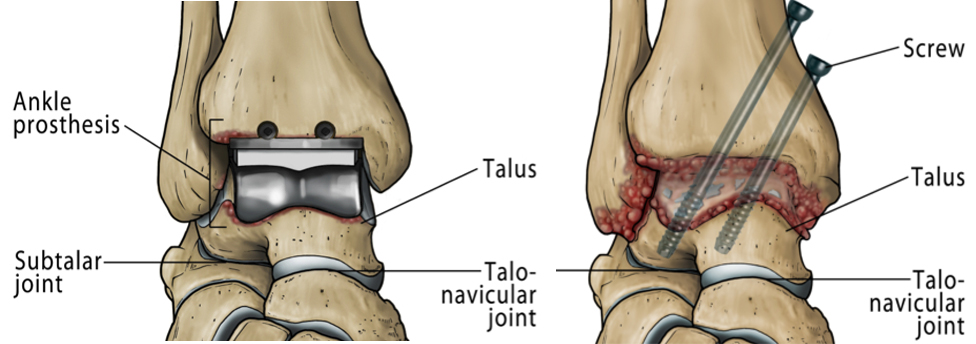“Which is better, a total ankle replacement or ankle fusion surgery?” Is a question asked by every patient thinking about surgery for ankle arthritis. In this article we try to answer the question ankle replacement or ankle fusion?
Ankle Replacement Vs Ankle Fusion
Most ankle arthritis can be treated without surgery. Non surgical treatments include activity modification, physical therapy, weight loss, supportive boots or ankle braces and pain killers. Once non surgical treatments have been exhausted then you may consider surgery. There are two recognised treatments for ankle arthritis. The traditional method for treating arthritis of the ankle is to convert a stiff painful joint into a stiff but painless one. This is called an ankle fusion or ankle arthrodesis. The second option is an ankle replacement where the joint is resurfaced just like a hip or knee replacement. Whilst a lot of doctors do not know an ankle replacement is even possible, fortunately, advances in technology plus our advanced understanding of how the ankle complex works, means that it is now very possible to replace the human ankle joint.
Ankle Fusion Surgery
This is still the commonest procedure carried out worldwide and can be a very successful treatment, but has its downsides. Because the ankle and foot have about 30 mobile joints, fusing just the ankle doesn’t mean you would walk with a peg leg, far from it. The other 29 or so joints compensate and so if you have healthy adjacent joints, then there is still quite a bit of motion. So in patients with healthy adjacent joints, you may walk normally and it might be very difficult for someone to know you have had an ankle fusion. However, because the ankle joint itself is now stiff then of course the other joints around it have to take on the extra load and they can, with time wear away and become arthritic and hence painful. Long term studies have shown that 100% of patients who have an ankle fusion have X-ray evidence of wear and tear of the adjacent joints within 10 years, but only a third of these patients limp and struggle because of this.
Ankle Replacement Surgery
An ankle replacement is where the ankle joint is resurfaced with metal implants and a plastic liner and because it maintains motion, theoretically lowers the risk of adjacent joint arthritis, but this remains to be proven. The main downside to an ankle replacement is that it is not commonly performed and hence it is very important that surgery is carried out by an experienced surgeon. The other issue is longevity. We do not know how long they will last. The current research suggests that ankle replacements fail at about a 1.9% each year. This means that after 10 years, it’s reasonable to expect that about 20% of ankles will have needed to be redone. Because the most modern of implants have only been around for the last 8-9 years we do not know how they will perform. It is expected that the results will equal or better the literature but only time will tell.
Ankle Replacement Vs Ankle Fusion Further Research
The most important point is that for most patients both an ankle fusion and an ankle replacement will improve a patient’s quality of life and their function so which procedure is better for you is a matter that you will need to discuss with your surgeon, as lots of factors will come into play in making a decision. These include your age, whether or not you have deformity or other associated medical problems such as poorly controlled diabetes or neurological disease. Most importantly, will be how healthy the joints around the ankle are. There are 30 joints in the foot and ankle and if they have disease, then fusing the ankle might not give you the flexibility you desire. Its also important to know whether you have arthritis of the hip or knee, as this can also impact on your outcome. I suggest that you ask your surgeon to comment on the health of all the joints in your lower limb before having surgery as this is possibly one of the most important signals for outcome of surgery.
There is only one very high-quality clinic study, called TARVA. Which compares ankle replacement against ankle fusion. This study was funded by a large public grant (an NHS NIHR HTA study). This study is a randomised controlled trial and involves 17 NHS centres across the UK and involves over 40 surgeons involved across the United Kingdom. The TARVA study aims to answer the questions, “In patients over 50 years old with end stage ankle arthritis, is an ankle replacement or an ankle fusion more likely to give a better outcome as judges by a clinical score”. The study not only looks to assess clinical outcome but also cost effectiveness of ankle replacement and ankle fusion. The initial early results will be published in the summer of 2020 but long term 2, 5 and 10 year results will follow later on. The initial report of the TARVA study was published at https://www.acpjournals.org/doi/10.7326/M22-2058
You can follow the trial on Twitter @TARVA_Trial.
Which is better, Ankle Replacement or Ankle Fusion?
So in summary, which is better? Both an ankle replacement and an ankle fusion will improve your quality of life. It’s best that you speak to your surgeon to find out which is best in your circumstances.
This article was written by Mr Andrew Goldberg, Consultant Orthopaedic Foot & Ankle Surgeon in London. He is the Director of the London Ankle & Arthritis Centre, and can be contacted on +44(0)207 042 1818 or by email at info@goldbergpp.com
Did you enjoy this article? You may also like;
How successful are ankle replacements?
Can I see some ankle replacement pictures ?
Can I do sports after an ankle replacement?
Jane’s Story – the arthritis fix that finally took away my agony

